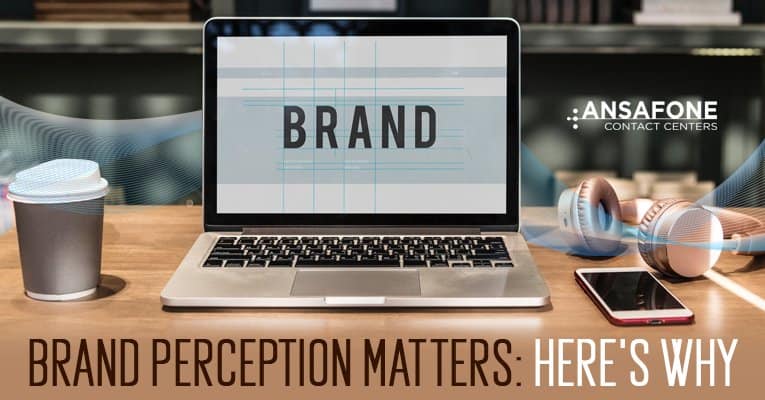It’s not enough to have a great product or service. The pivot point for any business’s success or failure is ultimately what and how customers feel about it. Customer relationships are the foundation upon which a company builds or destroys brand perception. Brand perception is the walls holding your business together. Communication is the tool that constructs those walls and monitoring all the above is the roof that protects your business. Let’s explore the structure of your house.
Why Brand Perception Matters
The opinions of today’s customers aren’t just reaching the few people in their immediate vicinity. A single social media post by a customer can be seen by thousands or even millions in a single day.
It’s not just reach, either. Buyers typically highly value and trust their peers when it comes to if they have recommended a product or service.
You might assume most people don’t take the time to share their opinion. However, a record 77 percent of customers report that they’d recommend a brand to a friend after a positive experience. Think for a moment about just the importance of this as free marketing source.
It’s no wonder that companies work to cultivate a positive brand perception to help them reach their targeted customers. Easy to say but unfortunately, hard to implement. Customers are less loyal and more knowledgeable than ever before. They demand exceptional experiences. They’re willing to hop from brand to brand until they find the one that best fits their needs and wants.
It’s crystal clear that the creation of a unique brand is important. For most small businesses, such as doctor’s offices and HVAC companies, the problem is a lack of understanding of consumer brand perception and performance monitoring.

Understanding Brand Perception
The root of brand perception is what a business says, how they say it, and how onlookers receive it.
Think of messaging like a sail for your branding ship. How the consumer interacts with the brand equates to the sea upon which that ship is sailing. You can guess what happens to the ship if the sea isn’t happy, right?
The love of a product keeps over 55 percent of customers loyal. Good deals and excellent customer service build satisfaction and loyalty. All of the above combine to form a customer’s brand perception. But, what about potential customers? Their perception forms as they read reviews, talk with friends, interact with staff, and initiate the questioning and purchasing processes.
When positive, this perception is what sways the consumer to consistently choose your business and recommend it to friends, family, fellow consumers. If negative, however, a customer’s brand perception isn’t just losing a single customer. They’re highly likely to tell others why their opinion of you is low and how your competitor captured their business.
The bottom line is each customer and their opinion matters. If it matters, then it must be monitored.
Why Monitoring Brand Perception Is A Must
A huge mistake many companies make is to assume they know what their customers think and feel based on the actual interaction points of sales. It causes companies to have an inflated ego about their own brand perception and assume it’s more positive than it really is.
A Bain and Company study recently highlighted this flaw. The study showed that 80 percent of companies felt they provided great customer service experiences. Meanwhile, only eight percent of the customers actually report having a positive experience.
If a customer were to call your business and their call goes unanswered, gets placed on a long hold, or reaches an employee that’s not so helpful because they’re multitasking between the phone and other duties, it’s very likely that the customer is going to end the call and call a competitor who is eager and able to accept their call.
Yet, it’s likely that the business owner in the above example was never aware of the problem and will likely never know until it’s too late if they’re not monitoring for customer experiences. Keep in mind that even if the caller schedules a service or purchase, they’re likely to share the negative phone experience in reviews that will ultimately deter others from even picking up the phone.
Monitoring provides insight on problems that can be easily solved, such as telephone communication inconsistencies and solutions such as an answering service to provide 24/7 or overflow response to customer calls.
Measuring reliability provides companies a more accurate and complete look at the what is killing or driving brand loyalty and customer satisfaction. The process begins and ends with listening. Active listening.
How To Measure Brand Perception
The web is huge. There are literally thousands of sites that give a voice and a huge audience to consumers. Monitoring is a must to get a truly accurate picture of brand perception. Here are some places to start:
1. Google Alerts
This tactic is a very effective tool to monitor when, where, and by whom your business is being mentioned online. It automatically does the searching for you based on keywords you select, such as your company name, product, or industry terms, and then sends you an email.
You can even set up keywords for potential problem areas, such as your incoming calls not being efficiently answered. If you see that customers are routinely mentioning your business’s name with poor phone customer service, then it might be time to explore the benefits of a small business answering service.
2. Online Reviews
Surveys have shown that over 90 percent of the 18-year-old to 34-year-old crowd trust the online reviews of strangers just as much as they do personal recommendations and over 90 percent are more likely to make a purchase after reading a review. This explains the success of sites like G2Crowd, Angie’s List, and Yelp. Routinely monitor the feedback such review portals offer and be sure to encourage customers to share their opinions.
3. Engage On Social Media
People are increasingly using social media as a portal to research products and services. Some of the top customer engagement  portals are social media outlets like Facebook and Instagram. Ninety percent of social media users have used social media to communicate with and/or research a brand. In fact, studies have shown that over 60 percent of consumers expect brands to utilize social media platforms for communication – not just marketing.
portals are social media outlets like Facebook and Instagram. Ninety percent of social media users have used social media to communicate with and/or research a brand. In fact, studies have shown that over 60 percent of consumers expect brands to utilize social media platforms for communication – not just marketing.
For business owners, this means that it’s imperative to have active social media pages that are engaging. Every comment, good and bad alike, needs to be met with a company response.
The web never sleeps and neither should your phone lines. Today’s customers demand connectivity. A small business answering service can provide solutions for everything from a doctor’s office that needs to have an open line of communication for patients after-hours to an HVAC or plumbing company in need of communication solutions for remote employees that can’t stop job progress to answer incoming calls.
4. Customer Surveys
Surveys remain one of the best monitoring tools for businesses to measure their brand perception at various points of contact during the customer’s journey. Such surveys measure the stickiness and satisfaction of a product, which provides marketing and development staff invaluable information on which to base their efforts.
CSAT, or customer satisfaction surveys offer measured data concerning a customer’s well-being and experience following a specific action. It is usually offered after a purchase, an in-store visit, or an interaction with customer service staff.
NPS, or net promoter score, is a single question form. It usually asks how likely the consumer is to recommend the brand. This is a fantastic gauge to identify brand assets and detractors in various stages of the customer-company interaction.
Again, this may alert you to specific communication breakdowns and the need for a more effective strategy, such as an answering service.
5. Feedback Program
Having a customer feedback program offers a constant influx of invaluable insights from the backbone of your business – customers. There will always be people who are just never satisfied with anything or anyone, however, you’ll find that most feedback offers a behind the curtain look into how audiences engage and react to your brand.
You can see a pattern of what works versus what needs to be improved based on recurring similarities between consumer opinion.
In closing, brand perception doesn’t have to be a mystery for your company. Once brand monitoring is initiated through surveys, engagement, and surveillance, companies can easily and accurately gauge brand perception and implement tools, such as outsourcing an answering service, to improve their customer service and image.
















